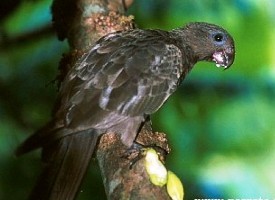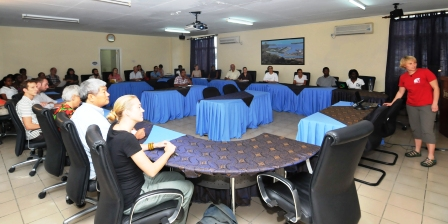Varsity student’s findings on black parrot bring wealth of information |17 October 2011

Her studies on the endangered and emblematic bird focused on its population, breeding, feeding habits and vocalisations and were done in collaboration with a number of local stakeholders, such as the Seychelles Island Foundation and the Seychelles National Parks Authority.
The project aimed to gather and make available information about the black parrot and help make management-level decisions on the way forward in protecting the best interest of the bird.
The presentation was held at the Seychelles Fishing Authority’s conference room, where a number of stakeholders had turned up to listen to Ms Reuleaux’ findings.
The student explained that according to her estimates, there are 520 to 900 black parrots in Seychelles and that international support and funding is still ongoing to date.
“No resident population of the birds has been found on Curieuse island and on Praslin, the highest parrot densities were found in palm forests and followed by mixed forests,” she explained.
Contrary to certain local perceptions, the parrots do not only eat fruit like mango, bilenbi, pawpaw and star fruits, but feed equally or even more on a variety of palm seeds and other plant species’ buds.

“Endemic species account for more than half of the diet, so endemic palm forests are vital for their survival, and although there is no apparent food shortage in the Vallée de Mai, the situation in other parts of the island needs to be examined.”
In monitoring their breeding habits, the research team mapped and checked potential nest sites, eggs and nestlings, and attempted to breed the birds.
“It was interesting to learn that the parrots live in polyandry, where there is one female and up to three males per nest, but only the female feeds the nestling. If there is a male in the nest and it has food, it will feed the female, who will then feed the young,” she said.
After presenting a number of other interesting facts, Ms Reuleaux said although the local black parrot population is larger than expected, the birds are still classified as vulnerable.
“Research still needs to be done on a number of other aspects relating to the birds, such as their calls, breeding and behaviour,” she said.
There are plans, though, to continue with the capturing, ringing and sampling of more birds, monitoring nest attempts, feeding habit both inside and outside of the Vallée de Mai.
Seychelles Islands Foundation representative Wilna Accouche said the information gathered will be very useful, as it will provide all walks of society – such as students, tourists and international scientific community – with the information they often ask for.
“Our biggest setback was that we had to start gathering information from scratch but using scientific methods, we were able to achieve our targets,” she said.
I.H.





